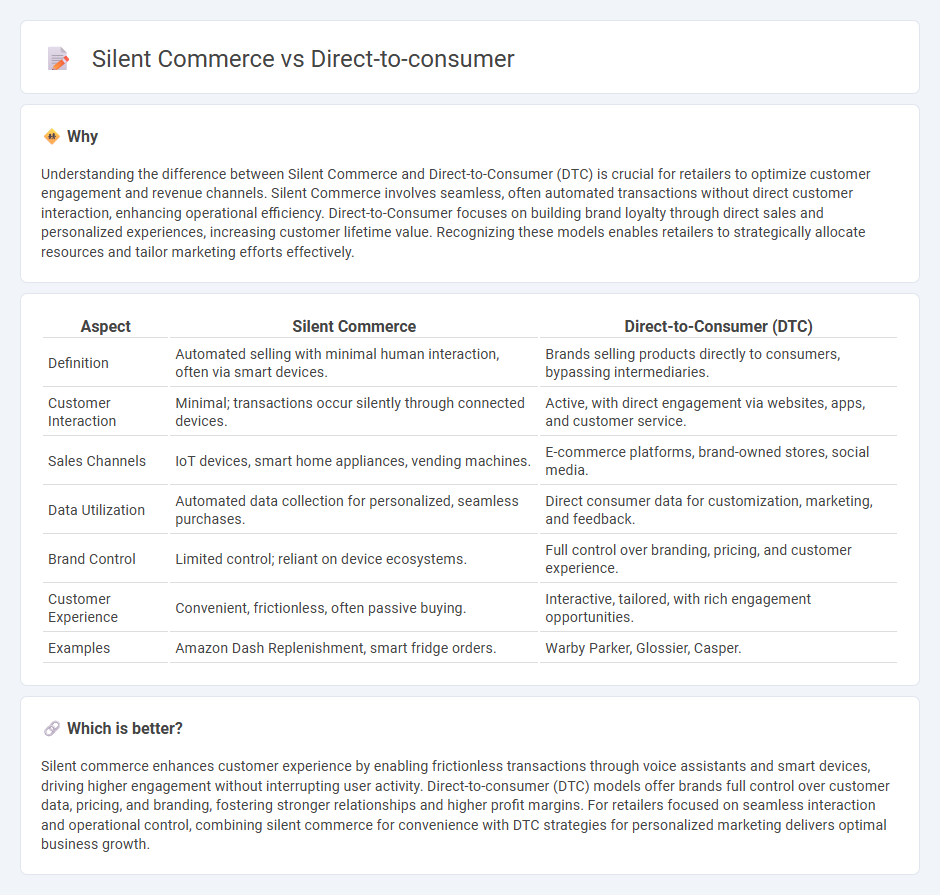
Silent commerce leverages automated technology and seamless integration to enhance customer experience without overt marketing, transforming traditional retail interactions. Direct-to-consumer (DTC) models bypass intermediaries, enabling brands to control the customer journey and increase profit margins. Explore how these retail strategies revolutionize market dynamics and consumer engagement.
Why it is important
Understanding the difference between Silent Commerce and Direct-to-Consumer (DTC) is crucial for retailers to optimize customer engagement and revenue channels. Silent Commerce involves seamless, often automated transactions without direct customer interaction, enhancing operational efficiency. Direct-to-Consumer focuses on building brand loyalty through direct sales and personalized experiences, increasing customer lifetime value. Recognizing these models enables retailers to strategically allocate resources and tailor marketing efforts effectively.
Comparison Table
| Aspect | Silent Commerce | Direct-to-Consumer (DTC) |
|---|---|---|
| Definition | Automated selling with minimal human interaction, often via smart devices. | Brands selling products directly to consumers, bypassing intermediaries. |
| Customer Interaction | Minimal; transactions occur silently through connected devices. | Active, with direct engagement via websites, apps, and customer service. |
| Sales Channels | IoT devices, smart home appliances, vending machines. | E-commerce platforms, brand-owned stores, social media. |
| Data Utilization | Automated data collection for personalized, seamless purchases. | Direct consumer data for customization, marketing, and feedback. |
| Brand Control | Limited control; reliant on device ecosystems. | Full control over branding, pricing, and customer experience. |
| Customer Experience | Convenient, frictionless, often passive buying. | Interactive, tailored, with rich engagement opportunities. |
| Examples | Amazon Dash Replenishment, smart fridge orders. | Warby Parker, Glossier, Casper. |
Which is better?
Silent commerce enhances customer experience by enabling frictionless transactions through voice assistants and smart devices, driving higher engagement without interrupting user activity. Direct-to-consumer (DTC) models offer brands full control over customer data, pricing, and branding, fostering stronger relationships and higher profit margins. For retailers focused on seamless interaction and operational control, combining silent commerce for convenience with DTC strategies for personalized marketing delivers optimal business growth.
Connection
Silent commerce leverages advanced technologies like AI and IoT to enable seamless, automated retail transactions without direct consumer interaction, enhancing the efficiency of Direct-to-Consumer (DTC) models. DTC brands utilize silent commerce to streamline supply chains, personalize customer experiences, and maintain control over branding and data. This integration reduces operational costs and accelerates market responsiveness, driving growth in the evolving retail landscape.
Key Terms
Brand Ownership (Direct-to-Consumer)
Direct-to-consumer (DTC) models enable brands to maintain full ownership over their customer data, marketing strategies, and sales channels, ensuring greater control over brand identity and customer experience. Silent commerce, by contrast, often relies on third-party platforms or marketplaces, limiting direct interaction with customers and reducing brand ownership. Explore how prioritizing brand ownership through DTC can elevate your business strategy and customer engagement.
Automated Transactions (Silent Commerce)
Silent commerce leverages automated transactions through AI-driven systems, enabling seamless purchasing experiences without active consumer interactions. It contrasts with direct-to-consumer models by prioritizing machine-to-machine communication and predictive analytics to anticipate customer needs, streamlining order fulfillment and payment processes. Discover how silent commerce is revolutionizing retail by enhancing efficiency and customer convenience.
Customer Data Control
Direct-to-consumer (DTC) models provide brands with full access to customer data, enabling personalized marketing and enhanced customer experience. Silent commerce prioritizes seamless transactions with minimal direct customer interaction, often limiting data collection to protect privacy. Explore how these approaches impact your business's control over customer insights and data strategy.
Source and External Links
Direct-to-consumer - Wikipedia - Direct-to-consumer (DTC or D2C) is a business model where brands sell products directly to customers, bypassing any third-party retailers or wholesalers, often via online platforms and sometimes complemented by physical stores; in 2021, US direct-to-consumer e-commerce sales exceeded $128 billion.
What Is Direct-to-Consumer? Everything You Need To Know (2024) - The DTC retail model allows brands to sell directly to customers through their own digital channels, giving them full control over marketing, customer relationships, and fulfillment, typically targeting a defined audience with limited product ranges and emphasizing customer experience and loyalty.
Direct to Consumer (D2C) Guide | Salesforce US - Direct-to-consumer describes brands selling products straight to end users rather than through retail partners, a practice growing rapidly with 64% of consumers regularly buying directly from manufacturers and expected DTC sales reaching over $200 billion by 2024, using channels like ecommerce websites, apps, and social commerce.
 dowidth.com
dowidth.com